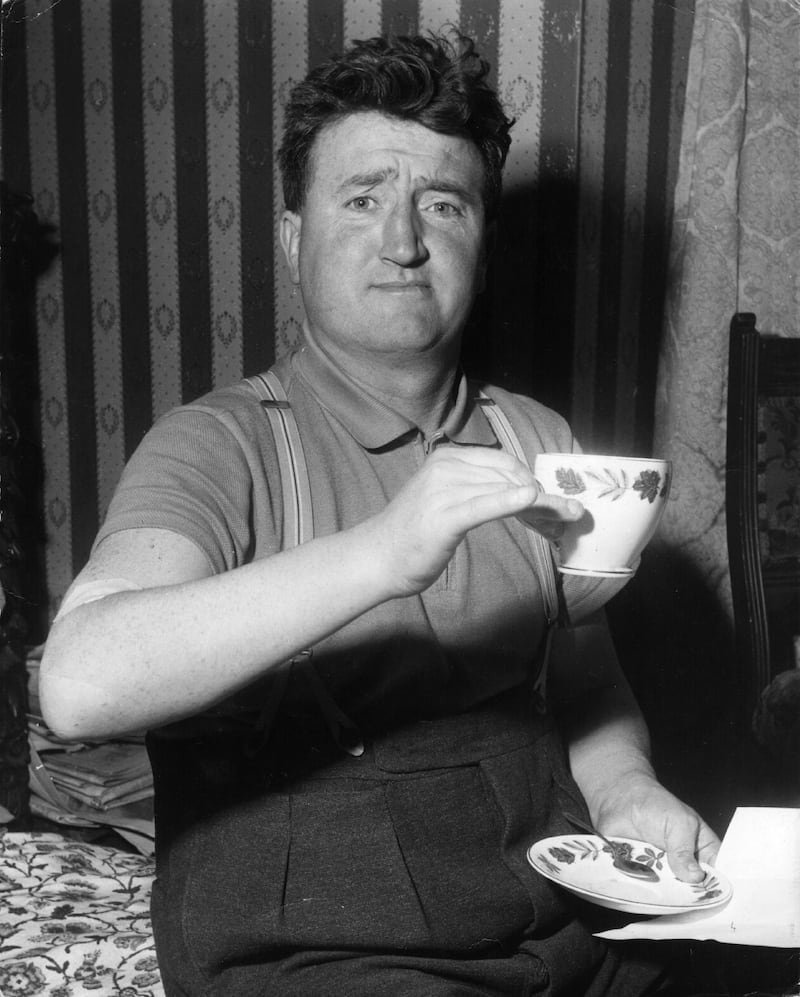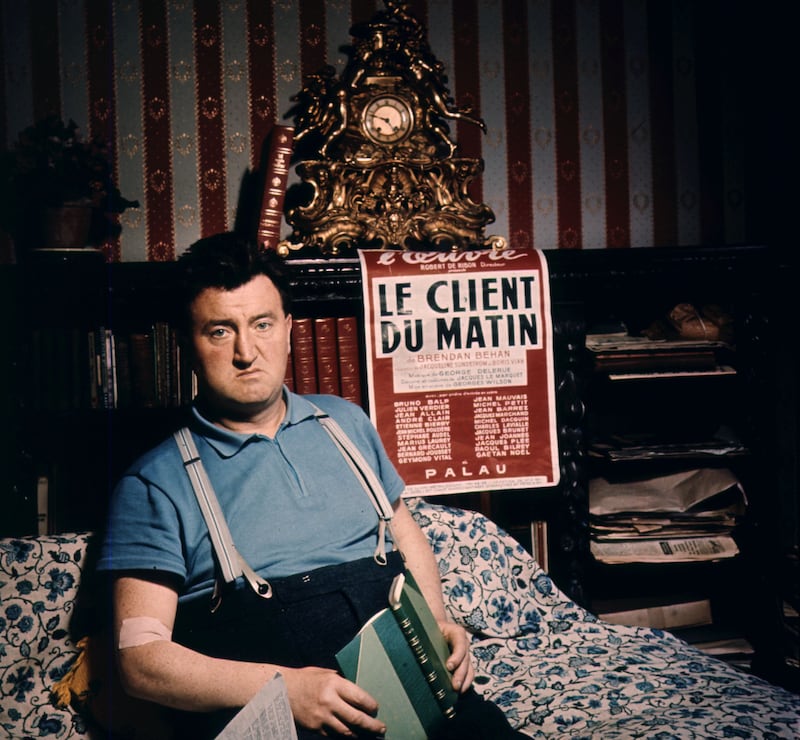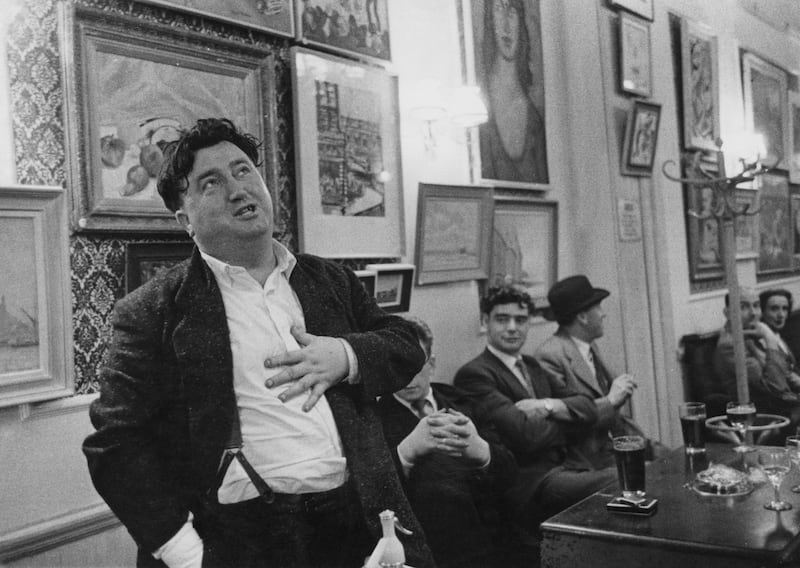As we reach the centenary of the birth of Brendan Behan – he was born on February 9th, 1923 – it’s a pretty safe bet that, if you were asked to conjure up an image of him, it’s very likely that you will picture him with his shirt wide open, a pint in hand and probably sporting the remains of a recent black eye. Although that does not fully represent the man, it has become the go-to photo for him, in the rare times he makes the news these days.
And while these colourful pictures might appear amusing, they don’t present the fully rounded image he deserves. Instead they betray far worthier versions of him. Because you don’t have to look far to discover that there are a number of Brendan Behans. A divine trinity of the father, the son and the holy ghost. Each plays as important a role as the next, with perhaps that first incarnation, the father, being the most significant of all.
The trinity began when a 19-year-old Behan, just six months after his release from a borstal, found himself sentenced to 14 years in prison for a botched gun attack on two detectives in Glasnevin. Even by then he had already made a name for himself and it was joked that the sentence reflected a year for every yard by which he missed his targets.
[ Shamrock Rovers, the Down footballers and bullfights - remembering Brendan BehanOpens in new window ]
While he was crushed by the heavy sentence handed down, his time in prison was to be fruitful, because it was in prison that he began to consider the idea of being a writer. Within weeks of his incarceration, Behan was spending all of his time in his cell writing short stories. Once he had been given permission, he submitted them to the Bell, the prominent Dublin literary magazine of the day, for publication.
READ MORE
Such was the talent evident in these stories that the Bell’s editor, Seán Ó’Foalain, wrote to the governor of Mountjoy asking whether it would be possible to meet the young author. An extraordinary request, considering he had just been jailed for attempted murder. Although permission was granted, Ó’Faolain and the Bell were forbidden from publishing any of Behan’s work.
Behan resolutely continued to write for the next four years until he was eventually released from prison under the 1946 general amnesty for republican inmates. Not long after, his work began to appear in print, heralding an impressive new talent on the literary scene. And by the end of the 1940s, the young Behan had suddenly given birth to a new incarnation. An older, wiser and more confident second member of the trinity now appeared and wasted no time taking centre stage.

But it wasn’t long until Behan found himself disillusioned with the literary scene he encountered in the bars of Dublin, so he headed to France to try to develop his craft. And while the drunken boor, who was to come to dominate proceedings, began to make brief, annoying appearances, he was to play only a minor role as Behan began mixing in Parisian literary circles, with Beckett and Camus among his new acquaintances. But again, restlessness took over, and soon Behan was back in Dublin.
In the short time he had been away, Dublin had become an exciting place for aspiring writers. The Bell had ceased publication in 1948 and, seeing an opportunity to fill the gap, a young artist, John Ryan, started a new literary magazine, Envoy, from offices at the top of Grafton Street. Soon, many of the Bell’s writers started to drift from what had become known as the “intensive care unit” at the Palace bar and began dropping their work off at Envoy’s office.
Payment was by cheque and it just so happened that a pub in which the authors could cash them sat conveniently across the road, down a side street. Soon McDaid’s was awash with writers and artists, setting the scene for an extraordinary decade of prose, poetry and playwriting that was to follow.

And if there were any doubts of Behan’s literary aspirations on his return from Paris, a short poem, Loneliness, published in Envoy’s January 1950 issue, removed them and placed him firmly among McDaid’s hierarchy.
The tang of blackberries
Wet with rain
On the hill top.
In the silence of the prison
The clear whistle of the train.
The happy whispering of lovers
To the lonely one.
Like its predecessor, Envoy only lasted a short time, ceasing publication in 1951. But by then the second of the trinity was firmly established on the literary scene and beyond, with the name Brendan Behan a respected one, following a number of talks and two short plays broadcast by RTÉ. Behan seemed unstoppable. Two years later a newspaper serial, The Scarperer, was commissioned by The Irish Times; the following year he became a columnist with the Irish Press. For someone who’d been locked up and forbidden to have their worked published barely six years earlier, it was an astonishing rise. But nothing like what was about to unfold.
Behan returned to his prison experiences once more in 1952, but this time it was to begin work on a stage play, The Twisting of Another Rope. He had sent it to the Abbey but it was rejected. But as luck would have it, a few streets away from McDaid’s, a small theatre, the Pike, had just opened in a tiny coach house on Herbert Lane. And just as Envoy had established itself at the heart of the city’s literary movement, so too had the Pike in the city’s theatrical scene, presenting acclaimed productions of European dramas on its tiny stage.
Licking his wounds from the Abbey’s rejection, Behan saw a new opportunity with the Pike. He dusted off his manuscript and submitted the play. The following year, with a little rewrite and a new title, The Quare Fellow burst on to the Irish theatre world in 1954 and established Behan as an exceptional new playwright overnight.

It was in 1956, after an acclaimed production in London, that Behan’s reputation exploded across the globe. A reputation that was to be cemented two years later when Borstal Boy was published, and a new play, The Hostage, again took the London stage by storm. An Giall was an Irish-language play written in 1957, commissioned and produced by Gael Linn. Joan Littlewood, the director of the London production of The Quare Fellow, asked Brendan for a translation of it.
But what eventually reached the stage showed more of Littlewood’s hand than Behan’s. Still, it was another huge success, leading to a number of Dublin begrudgers commenting that “Dylan Thomas wrote Under Milk Wood. Brendan Behan wrote under Littlewood.” Behan wasted no time in telling them what they could do with themselves.
However, as the 1950s came to an end, the final, more potent member of the trinity had started to gain prominence. Although he might not quite have been a stranger to the drinkers in McDaid’s and beyond over the years, it was when a drunk and dishevelled Behan appeared live on the BBC, causing uproar, that the time was right for the last of the trinity to take centre stage. However, this incarnation’s time would not to be as long lived, let alone as triumphant.
Whatever version of Brendan Behan you might find upon your bookshelf offers a rich, complicated and contradictory version of the other
Still, the 1950s was an astonishing decade for Behan. The enormous success of his novel and plays had given him a degree of financial stability that must have seemed unimaginable to many in McDaid’s, let alone the literary Dublin of today, with the playwright managing to buy a house on Anglesea Road, Ballsbridge with his royalties. But along with his growing finances, Behan’s drinking had by now got wildly out of control and was having a disastrous effect on his creativity along with his health.
The year 1960 had barely arrived when it became clear that Behan’s drinking had got so bad, that even the physical act of writing was beyond him. To his own dismay, he was reduced to dictating his works into a tape recorder and getting them typed up for publication.
The first of these arrived in 1962 under the title Brendan Behan’s Island. Another in the series, along with a memoir, was due to follow. But by the end of 1963 it was clear from a short television interview about the proposed abolition of the death penalty, filmed on the banks of the Dodder in Ballsbridge, that Behan’s health and appearance were in a dreadful state. Still today, 60 years on, it is hard not to feel the shock and sadness at his frail appearance.

The new year had barely arrived when Behan’s health deteriorated even further. Then, only a few weeks after his 41st birthday, he was admitted to the Meath hospital, seriously ill. Being a fighter all his life, Behan managed to cling to life for a few more weeks, before eventually passing away on the afternoon of March 20th. His old friend, confidant and publisher John Ryan, in his timeless memoir of the period, Remembering How We Stood, describes, in stunning detail, Brendan Behan’s final hours:
“The patient is unconscious and breathing heavily. A tube enters his throat beneath the ample, rounded chin; another, presumably for intravenous feeding, is connected to some part of the abdomen. A hand lies authoritatively across a generous chest – it is the poise that a politician might take after delivering a ponderous, post-prandial cliche, anticipating a round of applause. There is a Roman quality to the massive young head and the great mane of brown hair that tumbles rebelliously over the edge of the operating table...
“The breathing sound persists, relentlessly, like a metronome, while the stethoscope involuntarily keeps time. The only urgency is in that sound, the sound of the body’s motor, itself part of an abandoned vehicle, running out, on the last of its fuel.”
It’s probably just as well that no image of that remains. But whatever version of Brendan Behan you might find upon your bookshelf, or perhaps set off to enrich it with, each of the trinity offers a rich, complicated and contradictory version of the other. Yet each is a significant thread in the cultural fabric of the nation, and the tapestry is all the richer for them. And all because a young poet and short-story writer managed, in just a handful of years after leaving a prison cell, to establish himself, firmly, at the forefront of an astonishing literary decade, the likes of which we’ll never see again. Even if we live to be 100.















